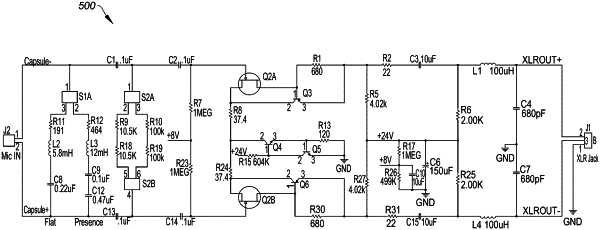| CPC H03F 3/1855 (2013.01) [H04R 1/04 (2013.01); H04R 1/2807 (2013.01); H04R 3/04 (2013.01); H04R 7/04 (2013.01); H04R 9/08 (2013.01); H03F 2200/03 (2013.01)] | 20 Claims |

|
1. A microphone system comprising:
a housing;
a microphone configured within the housing and including a transducer operable to generate a differential microphone output signal at the microphone output based on a detected audio input signal;
a pre-amplification conditioning circuit configured within the housing and comprising:
a pair of matched junction field-effect transistors (JFETs) configured in a differential pair with common-source configuration and, when biased, operable to:
receive the differential microphone output signal at corresponding gate electrodes of the matched JFETs; and
generate an amplified microphone output signal at corresponding drain electrodes of the matched JFETs;
a pair of bipolar junction transistors (BJTs) configured as a complimentary feedback transistor pair with each of the pair of BJTs coupled in parallel to a corresponding one of the pair of matched JFETs;
a current sink coupled to corresponding source electrodes of the matched JFETs and corresponding emitter electrodes of the BJTs, the current sink operable to maintain a fixed total direct current through each of the matched JFETs and BJTs,
wherein the BJTs draw current from the corresponding drain electrodes of the matched JFETs, which causes the matched JFETs to:
reduce their corresponding electrical load;
reduce signal noise generated by the matched JFETs; and
increase a maximum amplified microphone output signal level at the drains of the matched JFETs; and
a phantom power generation circuit configured to generate either 24 V or 48 V of DC phantom power,
wherein the pre-amplification conditioning circuit is DC biased via the phantom power generation circuit.
|